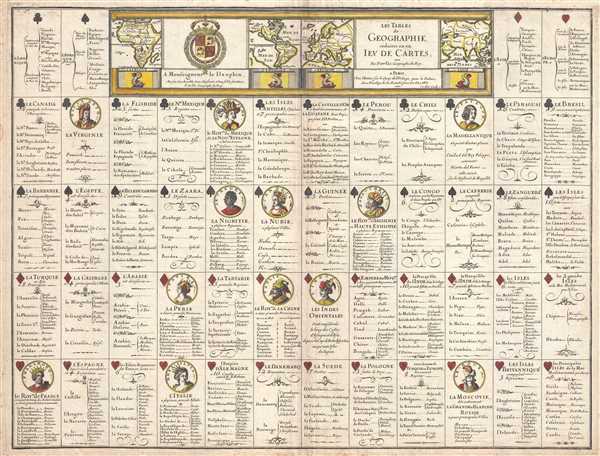This item has been sold, but you can get on the Waitlist to be notified if another example becomes available, or purchase a digital scan.
1669 Du Val Uncut Complete Set of Geographic Playing Cards of the World
GeographieJeuCartes-duval-1669
Title
1669 (dated) 16.5 x 21.75 in (41.91 x 55.245 cm)
Description
Each card, no matter its value, bears some text that imparts some knowledge about that card's country or region. For example, the eight of clubs is entitled Le Canada (Canada) and lists the '8 principle European colonies'. Six of the eight colonies, La Nouvelle France, La Nouvelle Bretagne, L'Accadie, La Nouvelle Angleterre, La Nouvelle Holande, and La Nouvelle Suede also have settlements attached to them, which include Boston, Manhattan (Manhatte), Montreal, and Port Royal. A decorative title cartouche is situated along the top border and includes illustrations of Africa, the Americas, Europe, and Asia. It is worth noting that, in the map of the Americas, California is depicted as an island and, on the New Mexico card (le Nouveau Mexique), which is the three of clubs, California is referred to as an island.
This set of cards was engraved by Robert Cordier and published by Pierre du Val in 1669.
CartographerS
Pierre Du Val (May 19, 1619 - September 29, 1683) was a French cartographer and publisher active in Paris during the middle part of the 17th century. He was born Abbeville, Picardie, France, where his father, also Pierre, was a merchant, consul, and alderman. His mother was Marie Sanson, sister of Nicolas Sanson d'Abbeville (1600-1667), the leading French cartographer of his day. Du Val and probably apprenticed in Sanson's workshops. Afterwards, in Paris, he studied geography under Jean-Baptiste Gault, who later became the Bishop of Marseilles. He counseled M. Henri of Savoye, abbot of St. Sorlin, and M. Gilles Bouraut, bishop of Aire and later Evreux, in matters of science and geography. Du Val became Geographe ordinaire to Louis XIV in 1650. His first atlas, the 1654 Cartes Geographiques Methodiquement Divisees, contained few of his own maps and was mostly compiled from reissues of maps by other cartographers. His early work focused on atlases and geographical treatises, but later, he turned his attentions to large separate issue, often multi-sheet maps. After his death in 1683, his widow, Marie Desmaretz, continued his business at least until 1684, after which it passed to his daughters (either Marie-Angelique or Michelle), who published until at least 1688. He is the elder brother of Placide de Sainte Hélène (1648 - 1734), Placidium Augustinum, an Augustine monk and geographer. More by this mapmaker...
Robert Cordier (16?? - c. 1673) was a French engraver and calligrapher active in Paris in the late 17th century. Originally from Abbeville, Cordier (and his brother Louis) were known for engraving works for Nicolas Sanson, who was also from Abbeville, and Hubert Alexis Jaillot. There are records of an engraver by the same name working in Madrid from 1629 - 1653, likely the same person. He also engraved images for the work of several prominent French novelists during his career. Learn More...

